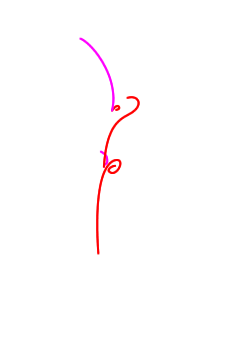

The First Neutral Current Event
At first sight, this rather unimpressive bubble chamber picture (taken at CERN in 1973 in the heavy liquid chamber Gargamelle) might not warrant a second look.
However, it is arguably the most significant ever taken because it records the first neutral current interaction – a significant milestone in the establishment of the unified `electroweak' theory of Glashow, Salam and Weinberg.
The interaction, a collision between an incoming ![]() and an atomic electron
and an atomic electron ![]() ,
shows up in the bubble chamber as a single electron (with an energy of about
385 MeV). It is identified because it spirals and
emits a bremsstrahlung photon
,
shows up in the bubble chamber as a single electron (with an energy of about
385 MeV). It is identified because it spirals and
emits a bremsstrahlung photon ![]() which
subsequently 'materialises' into an
which
subsequently 'materialises' into an ![]()
![]() pair.
pair.
It is worth pointing out that there is always a possibility that the electron was produced, not by a neutrino, but by a neutron, for example. Such 'backgrounds' are discussed in the paper below, but their conclusion was: '… the probability that the single event observed in the antinu film is due to non-neutral current background is less than 3 %'. In the paper announcing the discovery it says: 'A total of 370 000 neutrino and 360 000 antineutrino pictures were scanned twice and one single event satisfying the selection criteria was found in the antineutrino film'.
A reaction is ![]() , with only the final state electron making a track in the
bubble chamber.
, with only the final state electron making a track in the
bubble chamber.
It is interesting that this reaction implies the existence of a virtual neutral 'exchange particle', known as the Z0. The corresponding 'real' particle with a mass of about 100 times that of the proton was not discovered until 1983.
For more details, click here.